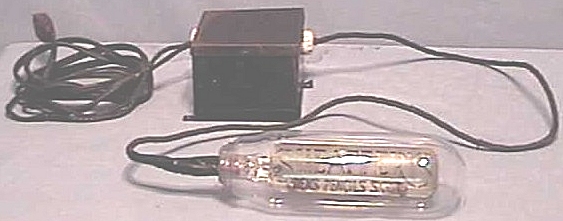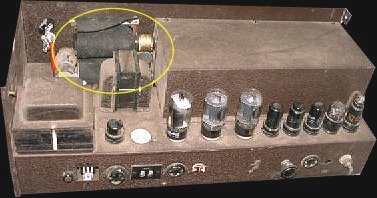X-ray
Geissler
Crookes
Radio
Box art
Dr. Hugh Hicks
S.Slabyhoudek
M-Jay
Fort Myers, FL.
Monsieur Ara
Fin Stewart
Related links
Submit a link |
|
| glow
lamps of Andrew F. Henninger, Jr. and Amglo |
3.31.2004 |
The name Amglo may not be a familiar one to figural glow light
collectors, however some very unique bulbs have surfaced that
should be of considerable interest to collectors. The Chicago
based Amglo was formed in 1935 by Andrew F. Henninger, Jr. Based on
bits and pieces of information it appears that Amglo first
started out manufacturing specialty or custom gaseous discharge
lamps including neon indicator tubes. In recent years some
examples of bulbs have become known that are clearly based
on Henninger's unique decorative glow light patents. The catalyst
for this article is the glow display pictured below which advertised Sheaffer's pens, pencils, and skrip.
 |
 |
I have known for some time that similar neon advertising
displays existed. An opportunity arose a few years
ago to purchase the Sheaffer's display. I was attracted
to the complex design of the display and the mystery
of who made it. Unfortunately there was nothing
to determine who made the display. There are no markings
on the bulb nor the electrical control box that
it was tethered to. Not having any other leads I
decided to spend some time on the USPTO website.
After several nights on the USPTO database I started
to come across some intriguing neon lamp patents
including those illustrated below from the 1930s.

The illustrations in the patents were similar in
appearance to the Sheaffer's display. After studying
the newly found patents, I decided the designs were
different enough to say for certain that the Sheaffer's
display did not match any of those described in the
patents. I gave up searching for more information until I
had a solid lead to follow. A couple of years later
I found the lead I was looking for completely by
accident.
I had just purchased an Amglo open spiral flash
lamp (ca.1950). The tube was still unused and in
its original packaging. The packaging listed several
patent numbers. Curiosity took me back to the USPTO
site where I plugged the numbers into the patent
database. The patents were filed by an inventor
named Andrew F. Henninger, Jr. This established
a link between Amglo and Henninger but I was still
no closer in identifying the Sheaffer's display
bulb.
While researching earlier Henninger patents I
came across one invention that dealt with an unusual
figural glow lamp that gives the illusion of motion.
More were found including a patent for a neon bulb
containing numbers or letters that could be arranged
to form a sign or address. The big break came when
I stumbled onto US patent No. 2,020,413
titled MEANS FOR OBTAINING FLAME EFFECTS IN NEGATIVE GLOW DEVICES filed May 18th, 1931
by Andrew F. Henninger, Jr.

The design illustrated in this patent clearly matched
the complicated construction of the Sheaffer's display. Confirmation
came recently when a similar bulb surfaced, having an intact base
bearing a large gold "Amglo" label. At last, the unusual
Sheaffer's neon display bulb was identified.
These lamps are quite complicated in design and
the inner details are very intricate. They were
probably difficult to produce and given their scarcity
today it is doubtful if any such bulbs were mass
produced. I found the Sheaffer's display with a small
black electrical box attached to it by way of a long
cord. The design of the display, as outlined in Henninger's
patent, lends itself to special visual effects
when the display is in operation. These effects are
not normally seen in the design of simpler figural
glow lights of the era such as those made by Aerolux.
By energizing and de-energizing certain electrodes
within the display it is possible to produce and
control unique glowing effects. In the patent such
effects are referred to as "flaming effects." The
black electrical box was the control box for this
display. By today's standards, the mechanical circuitry
inside the control box is crude but it did allow
current to be interrupted. Current is cycled by the use of small heating coils which act as thermostats which open and close a circuit dedicated to one particular electrode in the display. The result caused an eye
catching visual display inside the lamp and was probably
quite impressive given the technology at the time. The control circuit was an important part of the display's operation and Henninger filed for patent No. 2,072,622 Feb.16th, 1931 titled CIRCUIT FOR NEGATIVE GLOW DEVICES.
Shown below are close-up pictures of the Sheaffer's display made by Amglo. Clicking on the pictures
will bring up a larger image. Researching Sheaffer's
advertising tells us the display dates to the later
part of the 1930s based on the script of the lettering.
It is still unknown how the lamp was incorporated
into Sheaffer's advertising but one theory places
the lamp inside a point-of-purchase pen display case.
As hinted to earlier, other examples of Amglo neon displays have
become known. Below are examples from the collection of Chris Kocsis
. The "Music by Gabel" display tube was used in the 1930s
Charme jukebox manufactured by
the John Gabel Manufacturing Company
in Chicago. Both displays share the same characteristics
as the Sheaffer's display shown above and the Gabel display tube
still has a large Amglo label attached to the base.
The pictures shown below come courtesy of Bill Butterfield and illustrate how the Gabel lamp was incorporated into the Charme jukebox.
Amglo's family of early neon lamps also included indicator lamps.
The lamp shown below is a neon indicator lamp from the same era as the display lamps shown above. The construction of this lamp is very similar as well. Thanks to Peter Stonard for sharing these pictures.
One particular application has been discovered for this indicator
lamp. The 1937 Mills Studio jukebox employed these
lamps as visual displays for both their base and
treble controls. Similar in respect to the "magic
eye" or "tuneon" indicators used in vintage radios,
the Amglo indicators provided an attractive visual display when making tonal adjustments to the Mills
amplifier. Pictured below is a Mills amplifier for
the Studio model juke. Circled are the locations
of the two Amglo indicator tubes on the chassis.
The next picture shows the front face of the amplifier.
The two Amglo indicators can be clearly seen along
with a "magic eye" vacuum tube directly centered
above them.
 
Bill Butterfield has shared his pictures illustrating the appearance of the tubes when the jukebox is operating:
Lastly, the Abbott Vitamin Products display lamp pictured below surfaced on the auction site eBay in February of 2000 and is also an Amglo product:
As shown above, an interesting variety of neon lamps have been produced by Amglo based on Andrew Henninger's early patents. These lamps were probably made in limited quantities. Most appear to have been made for Chicago based companies during the mid 1930s. Browsing through Henninger's patents have revealed many more interesting designs such as the motion lamp shown below. This article is not intended to be the definitive
history of Amglo's neon lamps, but rather an introduction
based on the limited material I have on the subject.
I welcome you to contact
me with any additional information
about Amglo and Andrew Henninger's early glow lamp
patents.

List of Andrew F. Henninger's United States patents:
| US Patent No. |
Patent Date |
Patent Title |
| 1,938,538 |
12-05-1933 |
Negative Glow System For Creating Illusion Of Motion |
| 1,960,245 |
05-29-1934 |
Flashing Negative Glow Display Device |
| 2,002,775 |
05-28-1935 |
Cathode Glowlamp |
| 2,020,413 |
11-12-1935 |
Means For Obtaining Flame Effects In Negative Glow Devices |
| 2,057,522 |
10-13-1936 |
Negative Glow Lamp |
| 2,069,307 |
02-02-1937 |
Method Of Treating Electrodes oF Negative Glow Devices |
| 2,069,308 |
02-02-1937 |
Negative Glow Device |
| 2,072,622 |
03-02-1937 |
Circuit For Negative Glow Devices |
| 2,073,062 |
03-09-1937 |
Animated Figure Negative Glow Devices |
| 2,108,487 |
02-15-1938 |
Negative Glow Display |
| 2,210,718 |
09-06-1940 |
Electrical Display Device |
| 2,217,315 |
10-08-1940 |
Light Source |
| 2,219,923 |
10-29-1940 |
Battery Operated Gaseous Conduction Lamp Flasher |
| 2,266,037 |
12-16-1941 |
Electric Motor Apparatus |
| 2,273,520 |
02-17-1942 |
Light Source |
| 2,281,579 |
05-05-1942 |
Manufacture Of Gaseous Conduction Lamps |
| 2,282,582 |
05-12-1942 |
Motor |
| 2,457,891 |
01-04-1949 |
Electron Discharge Device |
| 2,516,209 |
07-25-1950 |
Electrical Flash Lamp System |
| 2,753,471 |
07-03-1956 |
Constant Speed D.C. Motor |
| 2,825,795 |
03-04-1958 |
Flashtube Mounting Structure |
Related Articles and links:
article index...
|
|
|
|











